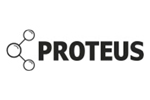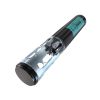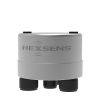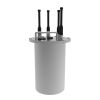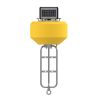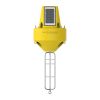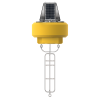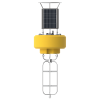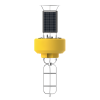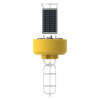Proteus EIDO Multi-Parameter Water Quality Sensors
Features
- Available in two sizes depending on the number of integrated sensors needed
- Built-in wiper cleans optical sensors prior to each measurement
- SDI-12 and RS-485 Modbus output for integration with data loggers & PLC's
- Expedited repair and warranty service
- Lifetime technical support
- More
The EIDO is a low cost, real-time sensing platform, specifically designed for monitoring organic water quality parameters including BOD, COD, TOC and Coliforms (total, E. coli or fecal). Following the success of the award-winning Proteus, the EIDO has been specifically designed as a low-cost option for the measurement of organic parameters. The EIDO has been designed for its ease of use, reliable data and economical operation even in the toughest applications. Available in two sizes, the EIDO 30 provides turbidity, TSS, temperature and two fluorometers; while the EIDO 35 provides turbidity, TSS, temperature and up to four fluorometers.
| BOD Parameter Specifications | |
| Units | BOD mg/l |
| Range | 0-2000 mg/l |
| Resolution | 0.01 mg/l |
| Accuracy | ±5 % of reading* |
| Comments | Local site calibration can improve accuracy |
| Coliform Counts Parameter Specifications | |
| Units | CFU/100 m |
| Range | >1 count/100ml |
| Resolution | 1 count/100ml |
| Accuracy | ±10 Coliforms* |
| Comments | Local site calibration can improve accuracy. Can be used for faecal coliforms, E. coli or total coliforms |
| COD Parameter Specifications | |
| Units | COD mg/l |
| Range | 0-4000 mg/l |
| Resolution | 0.01 mg/l |
| Accuracy | ±5 % of reading* |
| Comments | Local site calibration can improve accuracy |
| DOC Parameter Specifications | |
| Units | DOC mg/l |
| Range | 0 - 3000 mg/l |
| Resolution | 0.01 mg/l |
| Accuracy | ±5 % of reading* |
| Comments | Local site calibration can improve accuracy |
| TOC Parameter Specifications | |
| Units | TOC mg/l |
| Range | 0 - 3000 mg/l |
| Resolution | 0.01 mg/l |
| Accuracy | ±5 % of reading* |
| Comments | Local site calibration can improve accuracy |
| Temperature Parameter Specifications | |
| Units | Water Temperature |
| Range | -5 to 50°C |
| Resolution | 0.01 |
| Accuracy | ±0.1 |
| Comments | Never needs calibration. |
| Fluorometer Specifications | |
| CDOM/fDOM | 0 to 2500 ppb |
| Chlorophyll a - blue | 0 to 1000 ppb |
| Chlorophyll b - red | 0 to 1000 ppb |
| Crude oil | 0 to 1500 ppb |
| Fluorescein dye | 0 to 1000 ppb |
| Optical brighteners | 0 to 2500 ppb |
| Phycocyanin (freshwater BGA) |
0 to 1000 ppb |
| Phycoerythrin (marine BGA) |
0 to 1000 ppb |
| Refined oil | 0 to 10,000 ppb |
| Rhodamine dye | 0 to 1000 ppb |
| Tryptophan | 0 to 2500 ppb |
| Resolution | 6 digits with maximum of two decimals |
| Accuracy | Linearity of 0.99R² (temperature compensated 0-50°C) Accuracy ±0.5 ppb |
| Comments | Latest proFluor technology rated to 100m depth |
*after local calibration
| General Specifications - EIDO 30 | |
| Diameter | 76 mm (3.0”) |
| Length | 483 mm (19”) |
| Material | CPVC body and sensor guard |
| Typical Weight | 2.27 kg (5.00 lbs) |
| Number of Sensors | Up to 4 (2 fluorometers) |
| General Specifications - EIDO 35 | |
| Diameter | 89 mm (3.5”) |
| Length | 483 mm (19") |
| Material | CPVC body and sensor guard |
| Typical Weight | 2.85 kg (6.28 lbs) |
| Number of Sensors | Up to 6 (4 fluorometers) |
| General Specifications | |
| External Power | 5-15 vdc |
| Operating Temperature | 0 to 50°C, non-freezing |
| Calibrated Range | 0 to 30°C, non-freezing |
| Depth Rating | 200 m |
| Communications | USB, RS232, Modbus® RS485, SDI-12 as standard. Bluetooth® optional. |
| Sample Rate | 1 Hz |
| Data Memory | >1,000,000 logged readings |
| Logging Rates | 1 second to 1 day |
| Warranty | 2 years (All sensors) |
In The News
Supplying Seattle’s Drinking Water: Using Data Buoys to Monitor the Cedar River Municipal Watershed
Providing clean, safe, and reliable drinking water for the 1.6 million people in the greater Seattle area is a top priority for Seattle Public Utilities (SPU). With limited water supplies, SPU dedicates considerable resources to maintain its watersheds and mountain reservoirs. About 70 percent of Seattle Water comes from the Cedar River Municipal Watershed , and the other 30 percent comes from the South Fork Tolt River Watershed . [caption id="attachment_39574" align="alignnone" width="940"] Data buoy in Chester Morse Lake. Data buoy in Masonry Pool. (Credit: Kevin Johnson / Seattle Public Utilities) [/caption] Jamie Thompson, a fisheries biologist at SPU, monitors aquatic ecosystems centered on fish listed under the U.S. Endangered Species Act (ESA).
Read MoreData-Driven Advocacy on the Lower Deschutes River
Like many freshwater environments, the Deschutes River in Oregon is under pressure from development, pollution, and climate change. Many rivers, streams and lakes in the Deschutes Basin do not meet Oregon water quality standards –where state water quality monitoring assesses levels of bacteria, pH, dissolved oxygen, temperature, and fine sediment. Hannah Camel is the Water Quality Coordinator for the Deschutes River Alliance (DRA), a non-profit organization that focuses on the health of the lower 100 miles of the Deschutes River–the area most affected by human intervention. As a data-driven organization, the DRA has benefited from the installation of two NexSens X2 data loggers.
Read MoreExpanding the Port Everglades: Real-Time Monitoring of Water Quality Conditions from Planned Dredging Operation
The Port Everglades in Broward County, Florida, serves large trade vessels and cruiseliners and incoming and outgoing recreational boaters. However, as cargo ships become larger, the port must expand. A dredging project led by the US Army Corps of Engineers will substantially deepen and widen the port's navigation channel to accommodate larger Panamax cargo ships and modern cruise liners. As a result of this project, a large amount of sediment will be displaced into the water column. This suspended sediment may settle outside of the project area, burying benthic organisms like corals, and possibly carrying harmful particulates to other regions. [caption id="attachment_39497" align="aligncenter" width="2560"] A CB-950 and CB-25 deployed on site at Port Everglades.
Read More




